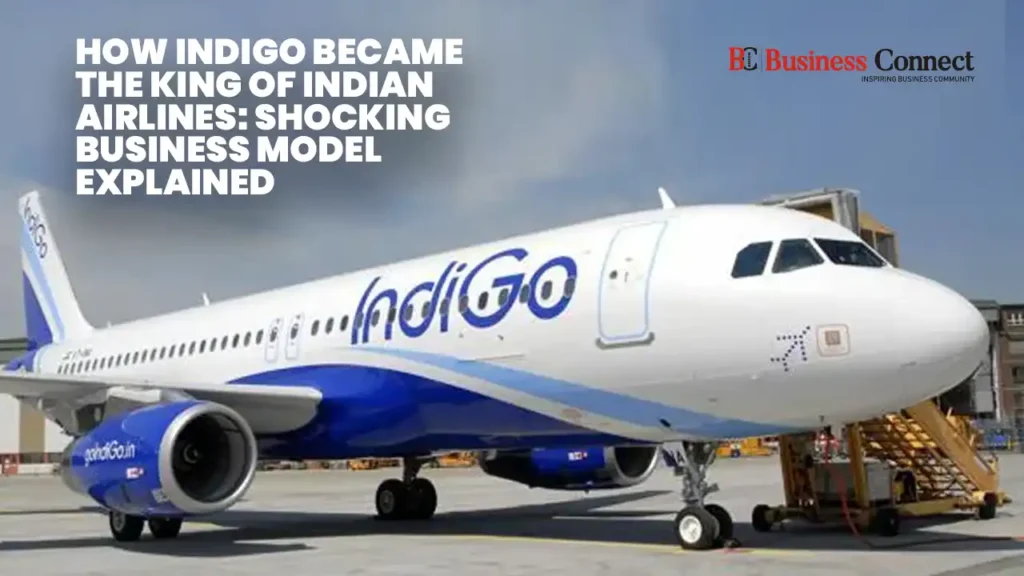IndiGo Airlines: The Secret Business Strategy That Dominates Indian Aviation
Written By Jaya Pathak
IndiGo became India’s dominant airline by pairing cost-discipline and punctuality with an asset‑light financing engine, enabling market‑leading scale, resilient profitability, and consistent network execution even amid industry shocks. The blueprint hinges on sale‑and‑leaseback aircraft financing, single‑minded operations, and a high‑frequency domestic network that now carries roughly two‑thirds of India’s flyers in many months of 2025.
Scale and market leadership:
By August 2025, IndiGo commanded 64.2% of India’s domestic market, holding above 63% every month that year, underscoring a scale moat that compresses unit costs and deepens demand capture across metros and Tier‑2/3 routes. The carrier’s leadership is not symbolic; DGCA traffic reports and leading coverage consistently place IndiGo well ahead of rivals on share and punctuality, reinforcing customer preference and slot productivity at congested airports.
Profitability with operating help:
Inter Globe Aviation reported its highest‑ever profit at ₹3,067.5 crore for the March 2025 quarter, with full‑year net profit at ₹7,258.4 crore (₹72,584 million), reflecting strong demand, disciplined execution, and improving ancillary yields. Passenger ticket revenue rose 25.4% year‑on‑year in Q4 FY25 and ancillary revenue increased 25.2%, indicating that ticket and non‑ticket levers both contributed to margin resilience.
The sale‑and‑leaseback engine:
IndiGo’s signature economic advantage is its use of sale‑and‑leaseback (SLB), in which aircraft purchased at attractive bulk terms are sold to lessors and leased back, unlocking upfront cash, preserving balance‑sheet flexibility, and aligning fleet costs with usage cycles. Analysts and industry commentaries have long noted that SLB can deliver per‑aircraft gains and structurally lower lease burdens over time, helping IndiGo fund growth while containing leverage during fuel spikes and demand shocks.
Network simplicity, reliability, and OTP:
A simplified operating model—high aircraft utilization, dense domestic rotations, and sharp turn times—translates into on‑time performance that repeatedly led regulator tallies, reinforcing IndiGo’s “gets you there” proposition for time‑sensitive business and leisure travelers. The same cadence extends to disruption playbooks; even with grounded A320neo family aircraft tied to Pratt & Whitney engine constraints, management trimmed the number of grounded frames from the 60s to the 40s by Q4 FY25 while sustaining growth and profitability.
Cost control as a cultural system:
Scale yields procurement power, but IndiGo’s advantage sits in systems: standardized processes, disciplined ancillary monetization, and network design that concentrates frequencies where demand is deep and seasonality predictable. The outcome is a lower cost per available seat kilometer (CASK) profile that supports fare competitiveness and withstands fuel volatility better than fragmented competitors, as evidenced by continued profitability in FY25 amid sector‑wide headwinds.
International growth, domestic core:
IndiGo’s international push remains measured and opportunistic, designed to extend utilization and yields without over‑exposing the balance sheet to long‑haul complexity or geopolitical shifts such as temporary airspace closures. In 2025, management acknowledged selective route suspensions and minor time‑penalty impacts linked to regional conditions, while reiterating confidence in network economics anchored by the domestic core.
Demand tailwinds and share defence:
India’s domestic traffic grew nearly 5% year‑on‑year in the first eight months of 2025, with IndiGo consistently clearing 63% monthly share as the market expanded and consolidated, supporting frequency adds and slot leverage at key hubs. Statista’s multi‑year view and mainstream reports corroborate IndiGo’s leadership through FY25, indicating a durable position that is difficult to challenge without equivalent cost, frequency, and punctuality.
Risk ledger and mitigants:
Key risks include engine reliability events, fuel price spikes, and regulatory or airspace disruptions that can elongate block times or cap capacity additions temporarily. IndiGo’s mitigants—SLB‑driven fleet flexibility, ancillary growth, punctuality discipline, and measured international exposure—have so far allowed profits to persist while capacity and passengers grew through FY25.
Why the model “won”:
IndiGo’s business model scales what matters most in Indian aviation: reliable departures, plentiful frequencies, and affordable fares backed by a financing structure that funds growth without undue leverage, converting operational rigor into defensible share and earnings power. In practice, that means IndiGo wins daily choices at the booking screen, a compounding edge that rivals find hard to unwind without replicating both the cost base and the cadence of execution.
FAQs:
- What is IndiGo’s market share in 2025?
DGCA‑tracked reports show IndiGo at 64.2% domestic share in August 2025, with monthly share remaining above 63% throughout the year to date.
- How profitable is IndiGo right now?
For FY25, IndiGo reported net profit of ₹7,258.4 crore, alongside its highest‑ever Q4 PAT of ₹3,067.5 crore, supported by double‑digit growth in passenger and ancillary revenue lines.
- What exactly is sale‑and‑leaseback and why does it matter?
SLB involves selling newly acquired aircraft to a lessor and leasing them back, releasing cash while maintaining access to the fleet, which supports growth, liquidity, and lower leverage across cycles.
- How have engine issues affected IndiGo’s fleet?
Management indicated grounded aircraft fell from the 60s to the 40s by Q4 FY25 due to Pratt & Whitney engine constraints, with the broader network still delivering profitable growth.
- Is domestic demand still growing?
Yes, domestic air traffic in India rose about 5% year‑on‑year between January and August 2025, a tailwind that supports IndiGo’s frequency adds and share defence at major hubs.



